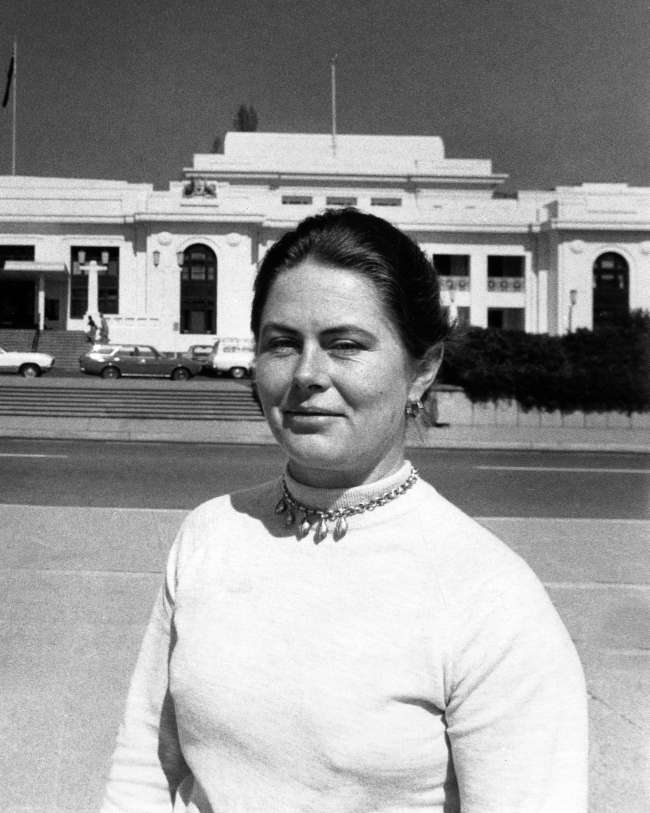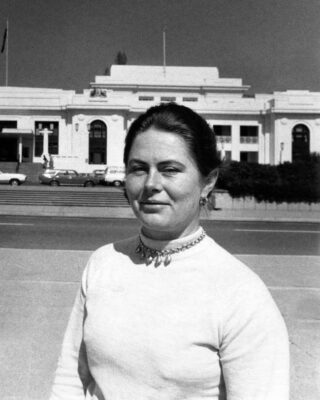- Entry type: Person
- Entry ID: AWE1115
Davidson, Gay
- Maiden name Yandle, Miringa Gay
Former married name Hillary, Gay

- Born 14 February 1939, Christchurch, , New Zealand
- Died 22 November 2004, Canberra, Australian Capital Territory, Australia
- Occupation Journalist, Print journalist, Radio Journalist, Television Journalist
Summary
Gay Davidson was the first female political correspondent for a major newspaper in Australia, the first woman President of the Australian Commonwealth Parliamentary Press Gallery, and a great mentor and friend to a vast array of journalists, not least women taking advantage of the openings to them in that profession during the 1970s and 80s.
Details
Miringa Gay Davidson was one of two children of Geoff Yandle and his wife, migrants to New Zealand respectively from England and Ireland, born when the family had a small dairy farm on the outskirts of Christchurch. She was educated at the (Anglican) Convent of the Sacred Name School, Christchurch Girls High School (1951-56) and at Canterbury University 1957-58 (degree not completed). She completed a journalism cadetship at The Christchurch Press.
Following a career in print, radio and television journalism in New Zealand she and her first husband, journalist Naylor Hillary, moved to Australia in 1967 when he was offered a PhD scholarship to study political science at the Australian National University in Canberra. Gay obtained work with the Canberra Times through her contacts with former New Zealand journalism colleague Bob Ferris (then Chief Sub Editor of the Canberra Times). Initially Gay and Hillary lived with Bob and his (then) journalist wife Jeannie Ferris. Gay pioneered the “Gang Gang” page 3 column in the Canberra Times, did civic rounds, covered education and health, was public administration writer, then political correspondent, ending as leader writer and senior columnist, before leaving the paper and working for public relations firm Hill and Knowlton. As Canberra Times political correspondent and head of bureau in the Parliamentary Press Gallery, she became both the first woman in such a role with a major Australian newspaper, and was elected President of the Parliamentary Press Gallery, again the first woman in such a position.
Along the way, she liberated the lavatories in the Parliament. One objection raised to her being appointed political correspondent had been the absence of a ladies’ lavatory within easy distance of the Canberra Times office in the Gallery. (At this time there were no ladies’ lavatories in the Senate for female Senators either and precious few for women Members of the House of Representatives). Gay assisted a woman teleprinter operator in the nearby offices of the Australian Broadcasting Corporation (who had broken her leg) to use the men’s lavatory near by, standing guard. In due course the Parliament’s Sergeant-at-arms was informed, and the lavatory was re-designated and appointed as a uni-sex facility-designated ‘toilet’.
She was a strong proponent of the establishment of a premise for the National Press Club. When the new building’s finances began to founder, she took over as President of the Club and, working closely with a new manager, Mrs. Marjorie Turbayne, she helped to put the Club on a firmer financial footing. She remained a member of the Board in various positions for many years.
As political correspondent she covered the 1974 Federal Election, and the dismissal of the Labor Government by the Governor-general in 1975. One enduring photo-image exists of her in the press on the steps of Parliament House as David Smith, then Secretary to the Governor General read out the Proclamation. Subsequently, she made her name writing about entrepreneurial corporate raiders in the business world from 1985.
In the community she sat on numerous Boards, including the (former) Canberra Hospital Board, the ACT Land and Planning Appeals Board, the Bruce Stadium Trust, and the Australian Institute of Health (now Health and Welfare). She held various offices with the (former) Australian Journalists Association. She was Deputy Chair of the Australian Institute of Political Science for some years, before being awarded Honorary Life Membership in 1999. During all this time she and second husband Ken Davidson (economics writer for The Melbourne Age) ran a virtual salon at their family home for journalists, politicians, their advisers, and senior public servants willing to risk dining in the presence of such company. She resigned (for the third and final time) from the Canberra Times in 1987.
After the tragic death in 1984 of her second daughter, Kiri Davidson, at the age of 13 of sub-acute sclerosing panencephalitis she became a prominent public campaigner for immunization against measles, working with successive Commonwealth Health Ministers in promoting what became the national Bicentennial Measles Campaign.
After Gay resigned from Hill and Knowlton in 1991, with a contract from the Commonwealth Department of Health to write and edit major papers, give political advice and run staff seminars on writing plain English, she worked free-lance and joined Alan Thornhill in their private company By-Line Products, again in the Gallery. She continued with some consultancy work, including speech writing, for Commonwealth Health Ministers until her deteriorating health precluded this.
Events
-
1967 - 1987
Career in journalism active
Digital resources
Published resources
- Book
-
Site Exhibition
- The Women's Pages: Australian Women and Journalism since 1850, Australian Women's Archives Project, 2008, http://www.womenaustralia.info/exhib/cal/cal-home.html
- From Lady Denman to Katy Gallagher: A Century of Women's Contributions to Canberra, Australian Women's Archives Project, 2013, http://www.womenaustralia.info/exhib/ldkg
-
Resource
- Trove: Davidson, Gay (1939-2004), http://nla.gov.au/nla.party-756064
